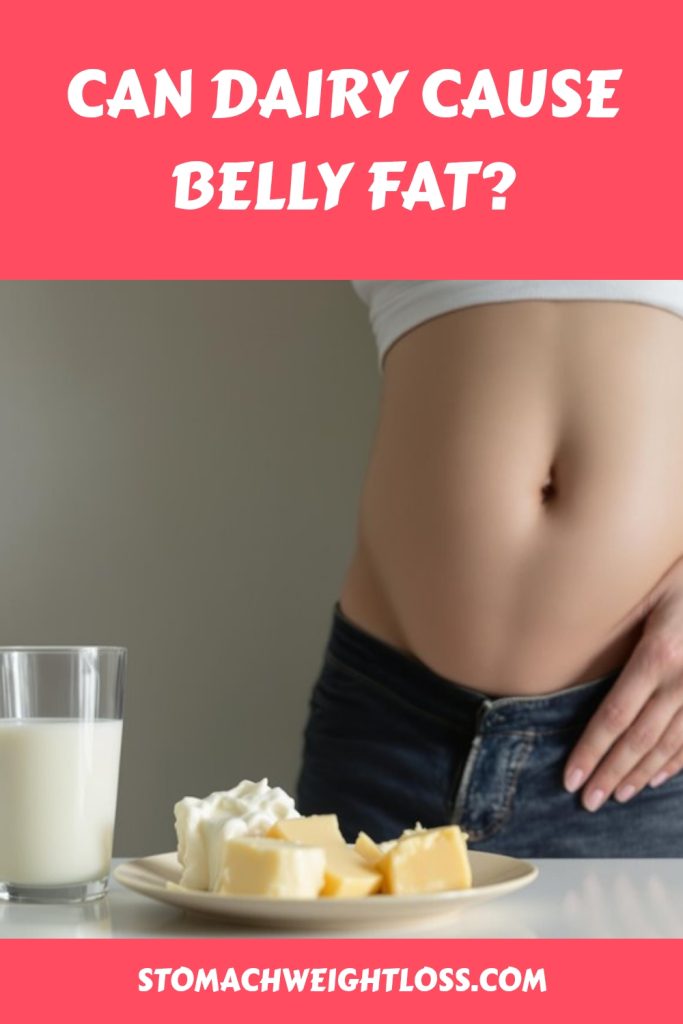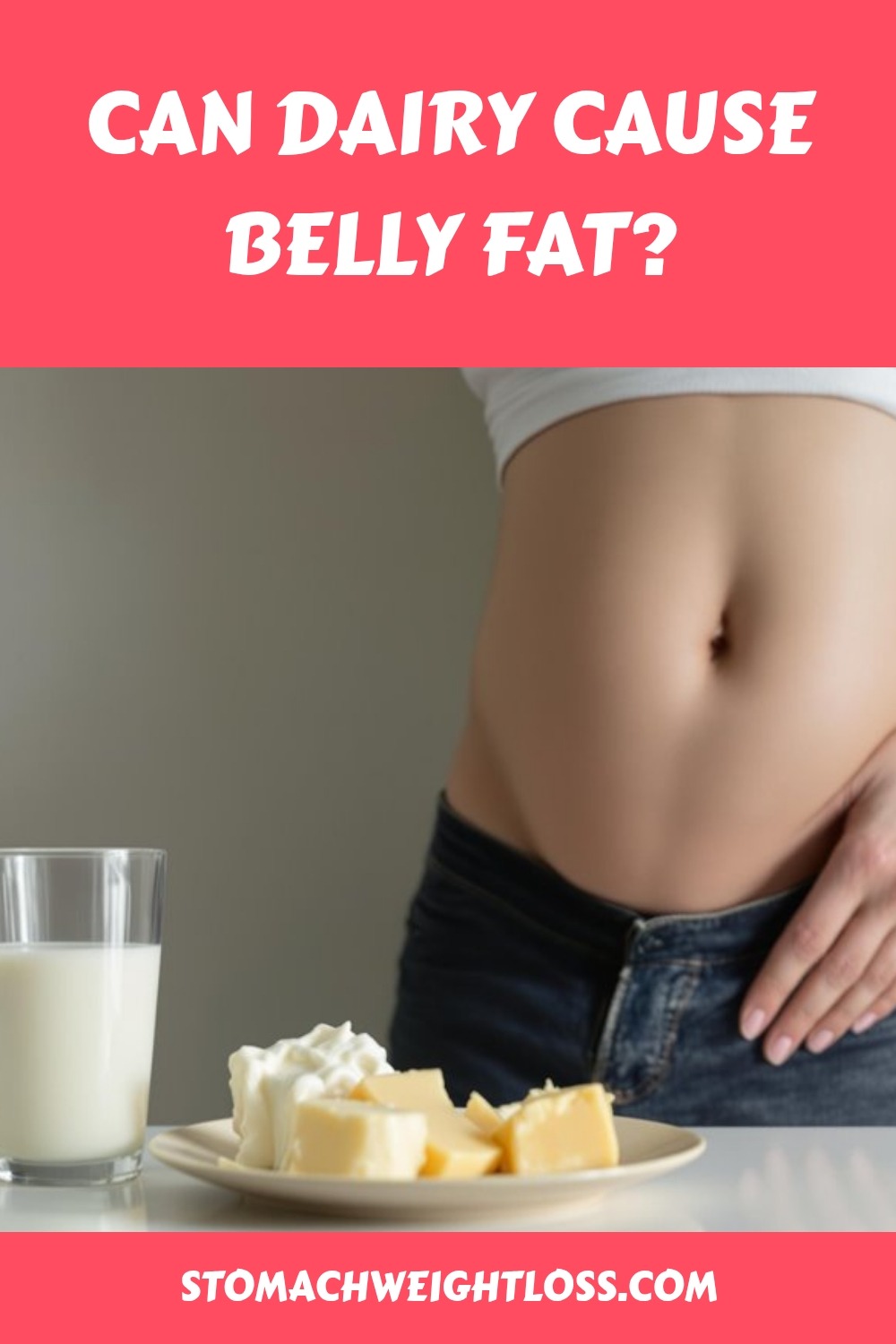This content is for informational purposes only, not medical advice, and may include affiliate links. We may earn a commission at no extra cost to you. See our Disclaimer for details.
While many people enjoy dairy products for their calcium and protein benefits, these foods may actually contribute to stubborn belly fat accumulation under specific circumstances. Your body’s response to dairy depends on several factors, including your sensitivity to milk proteins, if you are consuming full-fat or low-fat options, and your overall caloric intake. Dr. Michael Jensen of the Mayo Clinic notes, “Saturated fat from dairy can disproportionately accumulate in the abdominal region in susceptible individuals.” The connection between your morning yogurt and that expanding waistline might warrant a closer look at your dietary choices.
In a Nutshell
- Saturated fat in whole-fat dairy can influence fat distribution around the midsection, especially in post-menopausal women.
- Casein protein in dairy may trigger belly fat storage in sensitive individuals through inflammatory responses.
- Lactose intolerance affects 75% of adults, causing bloating that mimics belly fat and complicating weight management.
- Hidden dairy ingredients in processed foods contribute to unexpected calorie intake and potential fat accumulation.
- Studies show non-fat dairy is associated with reduced abdominal fat compared to whole-fat dairy products.
The Science Behind Dairy and Abdominal Weight Gain
When examining the relationship between dairy consumption and abdominal fat accumulation, researchers have identified several biological mechanisms that may explain this connection.
The saturated fat in whole-fat dairy products affects how your body distributes fat, particularly around your midsection, with post-menopausal women being especially vulnerable due to hormonal shifts.
Additionally, the protein casein found in dairy may trigger belly fat storage in sensitive individuals, while excessive consumption of high-calorie dairy creates a caloric surplus that leads to weight gain. For the 75% of adults with lactose intolerance, digestive discomfort often drives them toward calorie-dense alternatives that further complicate weight management.
Studies consistently show that non-fat dairy options correlate with reduced abdominal fat compared to their whole-fat counterparts. Hormonal changes, such as increased cortisol from stress, contribute to the persistence of belly fat, especially in women with larger waist circumferences.
Understanding Lactose Intolerance vs. Milk Protein Allergy
Why do some people experience digestive distress after consuming dairy products while others remain symptom-free? The answer lies in understanding two distinct conditions: lactose intolerance and milk protein allergy.
Lactose intolerance, affecting approximately 75% of adults worldwide, occurs when your body lacks sufficient lactase enzyme to break down milk sugar, resulting in bloating and gastrointestinal distress.
In contrast, milk protein allergy triggers an immune response to casein or whey proteins, potentially causing more severe reactions, including anaphylaxis.
Both conditions can impact your dietary choices and, when unmanaged, may contribute to weight gain and belly fat accumulation as your body struggles with improper digestion and inflammation.
How Casein Might Contribute to Belly Fat Accumulation
Casein’s role in belly fat accumulation represents a significant concern for those watching their waistlines, particularly following digestive issues like lactose intolerance.
This slow-digesting milk protein triggers elevated insulin levels that may promote visceral fat storage in your abdominal area. Research indicates that casein fermentation in your gut produces metabolic byproducts that specifically target abdominal fat distribution.
Casein’s slow breakdown process creates the perfect metabolic storm for stubborn belly fat accumulation.
“We’ve observed that individuals with sensitivity to milk proteins often experience inflammatory responses that exacerbate weight gain,” notes Dr. Helena Cartwright, nutrition researcher.
For effective weight management, consider monitoring your dairy consumption, as studies show reduced casein intake correlates with decreased belly fat—especially important if you’ve noticed inflammation after consuming dairy products.
The Role of Full-Fat Dairy Products in Weight Management
Despite their reputation as diet saboteurs, full-fat dairy products present a more nuanced role in weight management than many assume.
While higher in calories than their low-fat counterparts, they may actually support your weight loss journey through improved satiety and body composition effects. Consistent probiotic supplementation can lead to meaningful results in belly fat reduction within 8 to 12 weeks.
The relationship between full-fat dairy and belly fat isn’t straightforward. Research suggests moderate consumption within your overall diet won’t necessarily expand your waistline—some studies indicate it might help reduce belly fat by enhancing muscle mass while decreasing body fat percentage.
Inflammatory Responses to Dairy and Their Effect on the Midsection
For many individuals struggling with stubborn belly fat, the inflammatory response triggered by dairy consumption represents a hidden culprit that’s often overlooked in weight management discussions.
When you consume dairy products, particularly if you have lactose intolerance, your body may initiate inflammatory responses that contribute to abdominal bloating and increased visceral fat storage.
Research shows chronic inflammation disrupts hormonal balance, potentially increasing appetite and weight gain specifically around your midsection.
“The casein and whey proteins in dairy can provoke inflammatory cascades that directly affect how fat is distributed in the abdominal cavity,” explains gastroenterological research.
Eliminating dairy often improves gut health and reduces the inflammatory burden, potentially helping you shed accumulated belly fat.
Hidden Dairy in Processed Foods and Weight Implications
Beyond the obvious dairy sources in your diet, a concerning revelation for those monitoring their waistline involves the prevalence of hidden dairy ingredients lurking in processed foods.
Research shows that these concealed components greatly impact your abdominal fat accumulation through several mechanisms:
- Whey and casein in bread and snack bars contribute unexpected calories, challenging weight management efforts.
- Undetected lactose in “non-dairy” products can trigger digestive discomfort in those with lactose intolerance.
- Inflammatory responses from hidden dairy may increase belly fat deposition specifically.
- Ultra-processed foods containing dairy derivatives show strong correlation with increased abdominal adiposity.
For individuals struggling with persistent belly fat, scrutinizing labels for hidden dairy might be a crucial step in controlling caloric intake and reducing inflammation. Additionally, hormonal fluctuations during midlife, such as dropping estrogen levels, can further exacerbate abdominal fat storage, making it essential to be mindful of dietary influences.
Healthier Dairy Options That May Reduce Belly Bloat
Low-fat or non-fat dairy considerably reduces calorie intake and saturated fat consumption, potentially mitigating abdominal distension.
Lactose-free products offer digestive relief for those with intolerance, eliminating uncomfortable bloating symptoms. Fermented options like yogurt and kefir contain beneficial probiotics that support gut health, improving digestion efficiency. “
Controlling portion sizes remains crucial regardless of which dairy type you choose,” explains nutritionist Dr. Maria Chen.
Additionally, plant-based milk alternatives provide similar nutritional profiles with fewer calories, making them excellent substitutes for those particularly sensitive to dairy-induced belly bloat.
For optimal belly fat reduction, it’s beneficial to prioritize soluble fiber, which can be found in foods like oats and legumes, as it has been shown to help decrease belly fat over time.
Dairy Alternatives for Those Seeking to Trim Their Waistline
The expanding marketplace of dairy alternatives offers promising options for individuals focused on reducing abdominal fat accumulation.
Dairy alternatives provide strategic choices for those seeking to minimize stubborn belly fat deposits.
When pursuing weight management goals, consider these nutrient-dense, lower-calorie substitutions:
- Unsweetened almond milk contains merely 30-40 calories per cup, compared to whole milk’s 146 calories.
- Plant-based yogurts made from coconut or soy provide similar texture without the saturated fat content.
- Dairy-free cheeses derived from nuts or soy typically contain fewer calories that may contribute to belly fat.
- Fortified dairy alternatives deliver essential nutrients like calcium and vitamin D, maintaining a balanced diet.
These unsweetened options can support your waistline goals while providing nutritional adequacy, as stated by weight management specialists.
Creating a Balanced Diet Plan With or Without Dairy Products
Designing a balanced diet plan requires thoughtful consideration of your individual nutritional needs, regardless of whether dairy products feature in your eating pattern.
If you’re including dairy, opt for low-fat yogurt and milk to obtain essential nutrients like calcium while supporting weight management through controlled portion sizes.
When creating a caloric deficit, whole foods should form your foundation—vegetables, fruits, lean proteins, and complex carbohydrates—with dairy as a complement, not the focus.
For those with dairy intolerance, plant-based alternatives can seamlessly integrate into your balanced diet.
Be sure to scrutinize labels for hidden dairy ingredients in processed foods, which could unknowingly impact your waistline goals.
Incorporating high-fiber foods into your diet can help reduce belly fat, as they promote satiety and minimize calorie consumption.
Frequent Questions on Can Dairy Cause Belly Fat?
Will Cutting Out Dairy Help Lose Belly Fat?
By jove, cutting dairy might help lose belly fat if you’re lactose intolerant, as it’ll improve gut health. Choose dairy alternatives rich in dietary fiber for nutritional balance while monitoring caloric intake for weight loss.
What Is the Biggest Contributor to Belly Fat?
Your biggest belly fat contributors are poor diet, lack of exercise, and stress levels. Genetic factors, hormonal imbalances, age effects, sleep quality, inflammation issues, and fluid retention also play significant roles.
Should I Avoid Milk to Lose Belly Fat?
Like a puzzle with many pieces, you don’t need to avoid milk entirely. Consider low-fat milk alternatives, watch your calorie intake, maintain portion control, and pair with exercise to boost your metabolic rate for weight loss.
Why Do I Gain Weight in My Stomach Only?
You’re experiencing stomach bloating due to genetic factors, stress levels, hormonal imbalances, and diet choices. Your age effects metabolic rate, while decreasing muscle mass and fluid retention contribute to this specific fat distribution pattern.























